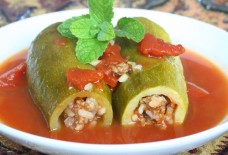Morocco's Wine and Cuisine Conquering America
By Karla Dieseldorff
Miami- We think of Morocco and we immediately picture amazing architecture, rich culture, savory cuisine, Arabic and Moorish influences amongst many other wonders, but do we think of Moroccan wine as a staple? Not really!
However, we might have even cooked some Moroccan recipe from well-known Paula Wolfert’s “The Food of Morocco” and enjoyed the spice-scented bestila or even the famous lamb tagine.
The Los Angeles Times interviewed importer Didier Pariente, who for the last 10 years has been introducing to the US, the wines of Ouled Thaleb – Morocco’s oldest working winery.
Since Morocco is a Muslim country and the consumption of wine is not a topic of common conversation, it has not been an easy task introducing the wine into the US market.
Pariente fancies Morocco’s wine and cuisine and he can be easily found enjoying a grilled sardine from a street stall in a Moroccan alleyway.
S. Irene Virbila for The Los Angeles Times visited with Pariente while he pampered his relatives in their Los Angeles home. He shared his love for Morocco and cooked miniature tagine dishes held olives spiked with harissa, chickpeas seasoned with preserved lemons and carrots scented with cumin.
Pariente served a chilled bottle of Moroccan rosé scented with strawberries, dry with a delicate bitter on the finish. The Moroccan rosé is a blend of 60% Syrah, 30% Grenache and 10% Cinsault. And at $14 or less per bottle it is quite desirable.
Virbila describes that for the entrées, Pariente brushed sea bass brochettes on the grill threaded with cherry tomatoes, zucchini and yellow bell peppers with chermoula, a marinade of olive oil with cilantro, garlic, paprika, cumin and a pinch of saffron. “My mother is from Fez, and this is her recipe — with a twist,” he says. Pariente is of Moroccan Jewish descent but grew up in France. Born with a natural talent to cook, he makes his own recipes.
While the brochettes finished cooking he broke eggs into a tagine pot bubbling on the barbecue. Like paella, you can cook tagine on an outdoor grill, he graciously showed.
Virbila notes that along with the fish, he poured a white wine made from the native Faranah grape blended with Clairette. “I call it a Moroccan Pinot Gris,” Pariente explains. “This is the wine they drink every day in Morocco.” Virbila describes it as lovely, ripe and round – an easy drink.
To accompany the tagine of kefta (beef and lamb meatballs) with tomatoes and poached eggs, Pariente served a couple of red wines, lightly chilled. The Cabernet/Grenache blend is fresh and spicy, but the Syrah is buoyant and refreshing, pure fruit, the very definition of a quaffable wine, the report tells us.
Pariente went on to add, “Morocco has a fabulous patrimony. Every trip there, I discover something new — a parcel of 90-year-old Carignane on its own rootstock or another vast old winery left behind by the French.”
California and its love for wine could not be left out and it is slowly venturing Moroccan wines at some Los Angeles-area restaurants’ lists. The report notes that the Syrah is on Patina’s wine list as a sommelier recommendation. L&E Oyster Bar, Bar Covell, Catch & Release, the Little Door, the Springs, Elf Cafe and Cleo are all pouring Ouled Thaleb wines. Moreover, these exquisites and colorful labeled Moroccan wines are appearing at wine shops, such as Buzz, Bar & Garden, Lincoln Fine Wines and Whole Foods.
America is discovering its love for these superb Moroccan wines, and just as Moroccan cuisine has seduced the US for many years…we have yet to learn and savor about these old-vine vineyards full of history and culture. This is without a doubt another great gift from Morocco.
Source: www.moroccoworldnews.com


